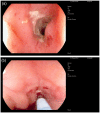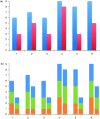Serial intralesional injections of infliximab in small bowel Crohn's strictures are feasible and might lower inflammation
- PMID: 25360319
- PMCID: PMC4212499
- DOI: 10.1177/2050640614547805
Serial intralesional injections of infliximab in small bowel Crohn's strictures are feasible and might lower inflammation
Abstract
Background: Crohn's disease can cause strictures throughout the gastrointestinal tract. Endoscopic balloon dilatation is a well-established treatment, but recurrence is seen in up to three out of four cases. Infliximab is playing an increasingly important role in the modern systemic treatment of severe Crohn's disease. Combining the anti-inflammatory effects of infliximab with the proven effect of endoscopic balloon dilatation could possibly improve outcome. In small studies, intralesional injections in perianal fistulas have been effective and endoscopic injection therapy in colonic strictures is feasible.
Objective: We wanted to assess whether serial intralesional injection of infliximab in small bowel strictures is feasible and reduces local inflammation.
Methods: We included six patients with Crohn's disease and inflammatory small bowel strictures. They were treated with endoscopic serial balloon dilatation. Subsequent to each dilatation, 40 mg infliximab was injected submucosally. A modified simplified endoscopic score for Crohn's disease was used for the involved area before the initial treatment and at the final follow-up after six months. Complications and development of symptoms were registered.
Results: Balloon dilatation and serial injection of infliximab were accomplished in five out of six patients. One patient completed the serial balloon dilatations and follow-up but received only one infliximab injection. The modified simplified endoscopic score for Crohn's disease decreased in all patients. There were no adverse events registered and all patients described themselves as feeling well.
Conclusions: Combining balloon dilatation of strictures with serial intralesional injection of infliximab in Crohn's disease of the small bowel is feasible and seems successful in reducing inflammation.
Keywords: Crohn’s disease; Double balloon enteroscopy; Endoscopic balloon dilatation; infliximab.
Figures



Similar articles
-
Endoscopic management of Crohn's strictures.World J Gastroenterol. 2018 May 7;24(17):1859-1867. doi: 10.3748/wjg.v24.i17.1859. World J Gastroenterol. 2018. PMID: 29740201 Free PMC article. Review.
-
Treatment of perianal fistulas in Crohn's disease by local injection of antibody to TNF-alpha accounts for a favourable clinical response in selected cases: a pilot study.Scand J Gastroenterol. 2006 Sep;41(9):1064-72. doi: 10.1080/00365520600609941. Scand J Gastroenterol. 2006. PMID: 16938720
-
Diagnostic and therapeutic yield of push-and-pull enteroscopy for symptomatic small bowel Crohn's disease strictures.Eur J Gastroenterol Hepatol. 2007 Jul;19(7):529-34. doi: 10.1097/MEG.0b013e328012b0d0. Eur J Gastroenterol Hepatol. 2007. PMID: 17556897
-
The Utility of Magnetic Resonance Enterography and Double Balloon Enteroscopy-Assisted Endoscopic Balloon Dilatation for Small Bowel Strictures in Crohn's Disease: A Retrospective Observational Study.Inflamm Intest Dis. 2024 May 20;9(1):147-156. doi: 10.1159/000539401. eCollection 2024 Jan-Dec. Inflamm Intest Dis. 2024. PMID: 39015256 Free PMC article.
-
Dilation of colonic strictures by intralesional injection of infliximab in patients with Crohn's colitis.Inflamm Bowel Dis. 2008 Feb;14(2):213-6. doi: 10.1002/ibd.20318. Inflamm Bowel Dis. 2008. PMID: 18022870 Review.
Cited by
-
Advancing therapeutic frontiers: a pipeline of novel drugs for luminal and perianal Crohn's disease management.Therap Adv Gastroenterol. 2024 Dec 19;17:17562848241303651. doi: 10.1177/17562848241303651. eCollection 2024. Therap Adv Gastroenterol. 2024. PMID: 39711916 Free PMC article. Review.
-
Surgical Considerations in the Treatment of Small Bowel Crohn's Disease.J Gastrointest Surg. 2017 Feb;21(2):398-411. doi: 10.1007/s11605-016-3330-9. Epub 2016 Dec 13. J Gastrointest Surg. 2017. PMID: 27966058 Review.
-
Towards the Oral Treatment of Ileo-Colonic Inflammatory Bowel Disease with Infliximab Tablets: Development and Validation of the Production Process.Pharmaceutics. 2019 Aug 23;11(9):428. doi: 10.3390/pharmaceutics11090428. Pharmaceutics. 2019. PMID: 31450748 Free PMC article.
-
Endoscopic management of Crohn's strictures.World J Gastroenterol. 2018 May 7;24(17):1859-1867. doi: 10.3748/wjg.v24.i17.1859. World J Gastroenterol. 2018. PMID: 29740201 Free PMC article. Review.
-
Review on Advances in Pediatric Endoscopy in the Management of Inflammatory Bowel Disease.Curr Pediatr Rev. 2025;21(2):154-165. doi: 10.2174/0115733963268547231128101929. Curr Pediatr Rev. 2025. PMID: 38265388 Review.
References
-
- Van Assche G, Rutgeerts P. Medical management of postoperative recurrence in Crohn’s disease. Gastroenterol Clin North Am 2004; 33: 347–360 - PubMed
-
- Nguyen SQ, Teitelbaum E, Sabnis AA, et al. . Laparoscopic resection for Crohn’s disease: an experience with 335 cases. Surg Endosc 2009; 23: 2380–2384 - PubMed
-
- Gardiner KR, Dasari BV. Operative management of small bowel Crohn’s disease. Surg Clin North Am 2007; 87: 587–610 - PubMed
-
- Rutgeerts P, Geboes K, Vantrappen G, et al. . Predictability of the postoperative course of Crohn’s disease. Gastroenterology 1990; 99: 956–963 - PubMed
LinkOut - more resources
Full Text Sources
Other Literature Sources

